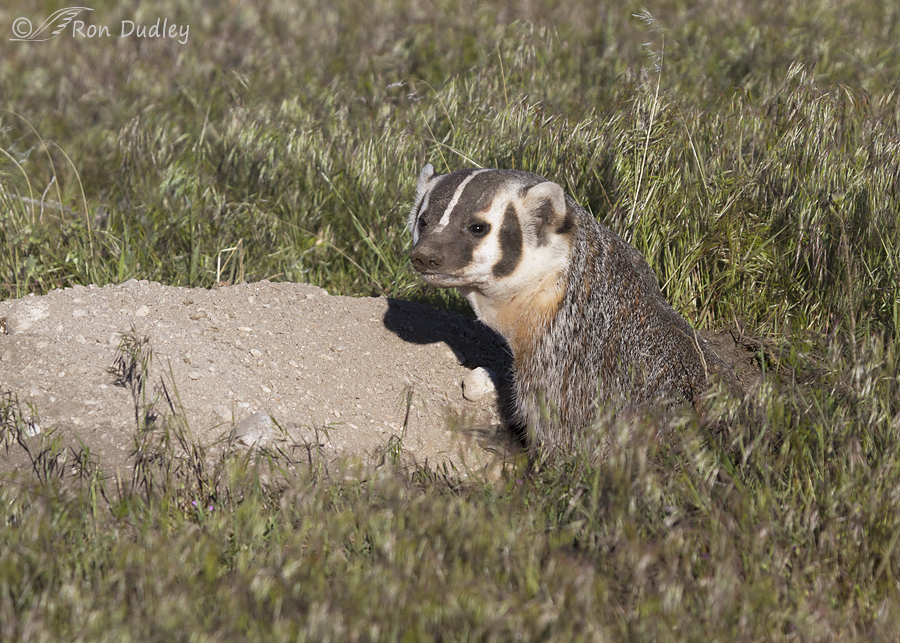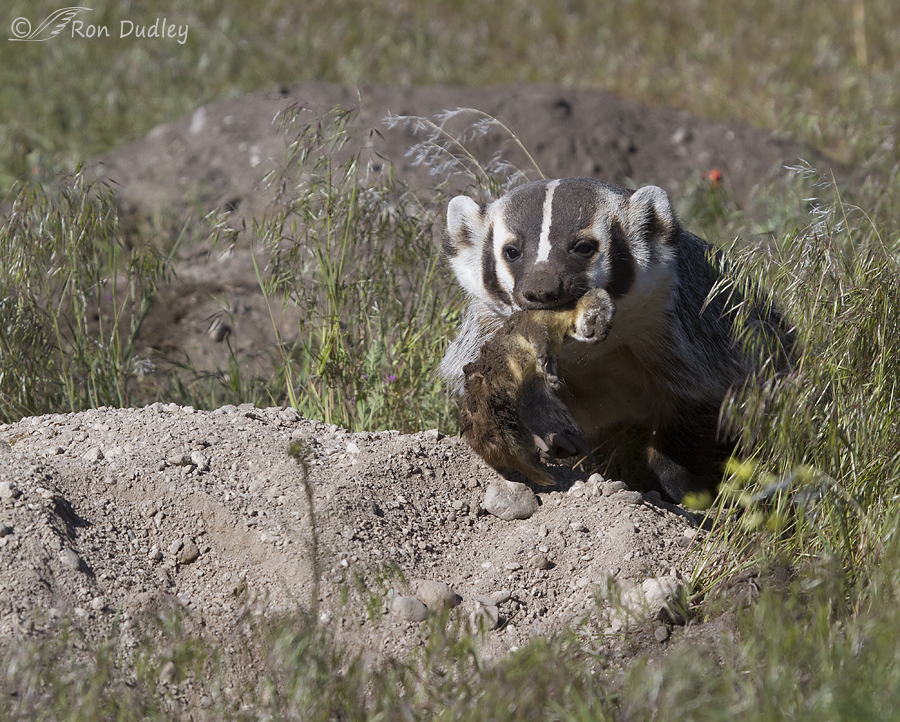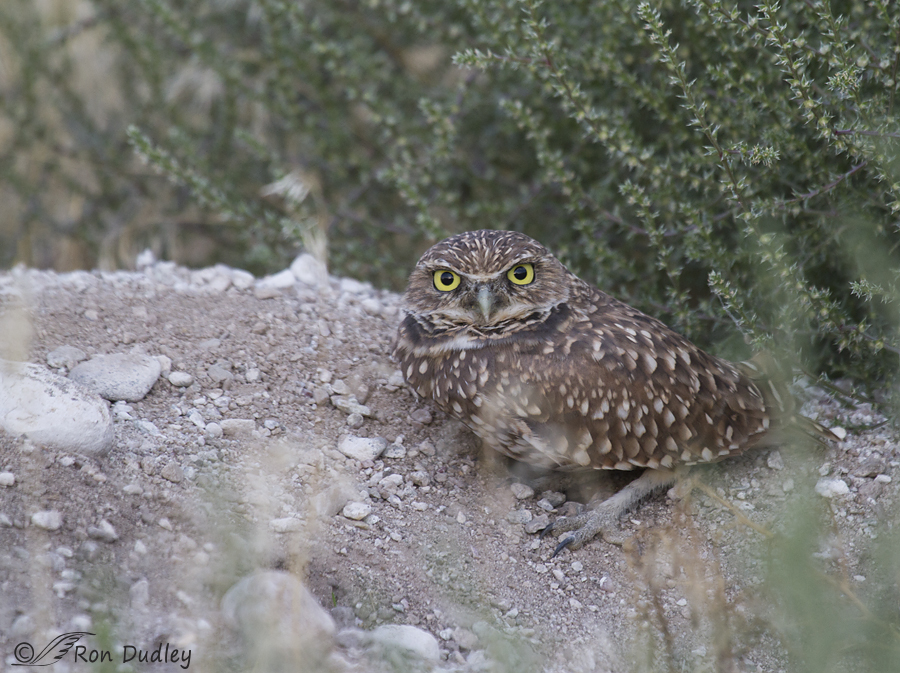Despite their name Burrowing Owls seldom dig their own burrows, even though they’re fully capable of doing so. Most often they occupy abandoned burrows dug by other burrowing animals such as badgers, ground squirrels, prairie dogs, skunks, marmots, kangaroo rats, armadillos and even tortoises. Once occupied, these “borrowed burrows” are renovated and maintained by the owls by digging but Florida Burrowing Owls are the only ones that normally excavate their own burrows (I wonder why that’s true – a dirth of burrowing mammals in the Sunshine State, perhaps?)
I’ve been aware for years that these owls sometimes take over badger holes but it’s something I’ve never been able to document without question until this week.

Some readers may recall this Antelope Island badger that I posted about last May. It was popping in and out of a recently dug hole and it was obvious that the badger had been the primary excavator.

There were actually two holes adjacent to each other (you can see the other, darker burrow mound behind the badger) that were most likely separate entrances to the same burrow. The badger had killed a Long-tailed Weasel and in this image it’s about to disappear down the burrow with the weasel.
The badger hole is within about six feet of a road on the island and I’ve been watching it carefully all summer but never saw the badger (or any other critter) there again. It had obviously been abandoned because there were never any fresh tracks or scat around the dirt mound.

But a few days ago after being gone for six days on our Montana camping trip it became obvious that in my absence the burrow had been “purposefully recycled” and was now occupied by at least one Burrowing Owl. Here you see the owl on top of the mound of the same badger hole. The light and angle were poor and there are out of focus obstructions in front of the bird but this image documents for me the fact that the badger hole now has a new tenant. I also thought it was interesting to see the difference in vegetation around the burrow over four months. Cheat Grass was the dominant plant around the burrow back in May but now the grass has been displaced by other vegetation.
The natural skeptic in me always appreciates being able to observe or document natural history “factoids” that I’ve always assumed to be true because somebody else said it was so.
This owl at a badger hole was one of those…
Ron


Thank you for your dedication to this observation. It is very helpful for conservationists who are aware of reuse of American Badger burrows by other species, such as burrowing owl. Great photos and also greatly appreciate your respect for observation from a distance.
If I lived a where Elli Baby does, I’d put up a sign that said, “Politicians, Frackers, and anti-environmentalists, please use front door”
HI! Love this Blog! Keep up the great photo’s!
Oooh. Recycling at its best (by one of the cutest). Burrows and holes in the ground more generally are too often taken over by snakes here. Of the venomous variety.
And you Aussies certainly have more than your fair share of venomous snakes, Elephant’s Child. When’s the last time you put your bare hand down one of those burrows?…
It will be the first of never before I put my hand down a hole here. If I can’t see the bottom it is no go territory. I respect them but I am not a fan of snakes. At all. In one of our homes a red-bellied black (venomous of course) lived under the front steps. For about ten months of the year I only used the back door.
I’ve heard that that species is common in urban areas down there. I think I’d have put a snake-warning sign up near my front door to keep sales-persons, missionaries and other undesirables at bay…
Or a sign which encourages them to play with each other… At the time we were living in the country. And the red-bellied blacks are among our least venomous snakes. We had the others too.
I’ve always thought that the FL BUOWs dug their own holes because the ground was so sandy, and thus much easier than throughout most of the rest of their range. But you’re right, they can certainly extend holes and I know at one facility where they were being captive bred, they dug out of the enclosure, so I would assume they can dig them as well. I’ve also thought that one of the reasons they like to recycle burrows is that they appreciate being around the mammalian denizens of nearby burrows (maybe not badgers or weasels so much!), as that gives them extra eyes out for predators.
That bit about sandy soil makes perfect sense to me, Louise, as does the possible benefit of having the eyes of other burrowing mammals nearby. Another little quirk about the selection of their nest burrow – they often (apparently deliberately) select a burrow that is close to a road (as noted by BNA). That fits with what I’ve seen also.
Very interesting Ron. I follow a few Burrowing Owls but did not know that they didn’t make their own hole. I hope they make sure it is empty before jumping down in there! Love the photos too. Thanks Ron.
Debbie, From what I’ve read, burrow selection is typically done at night. I wonder if that’s somehow related to avoiding nasty encounters with active rodents (ground squirrels, prairie dogs etc) who I would assume would be sleeping and less alert when the owl went down the hole to inspect it (wild speculation on my part, of course…)
This is absolutely fascinating, and the photographs are excellent, as usual. I am not familiar with the burrowing owl, so must go now and read up!
Thank you for sharing you knowledge and beautiful pictures with us!!
Thank you, Jane. Enjoy your reading!
I don’t know about burrowing mammals in Florida, but there are plenty of gopher tortoises – perhaps the Florida subspecies sometimes uses their burrows?
Andrew, They’re documented to use tortoise burrows so I suspect that would include gopher tortoises in Florida.
Burrowing owls always make me smile!…We two-leggeds can earn a lot (if we’re smart enough) about recycling from other critters…preservation of effort, materials and resorces, for example…and we need to, if we’re to survive…I wonder how that badger was able to capture a creature as quick and nimble as a weasel…
I wondered the same thing, Patty. There was actually a second (live) weasel at the burrow and it (believe it or not) followed the badger down the hole after the second badger shot was taken. It didn’t linger down there for long though, for obvious reasons…
Wonderful shot and info. Ron!
Charlotte
Thanks, Charlotte.
Great story thanks!
Thank you, Spencer.
That is some glare on the part of the owl. Definitely a squatter’s stance – “Ya gonna make somethin out of it??!”
Well, good for the owl!
You’re right, Alison. That burrow is so very close to the road that I fear it may not be occupied by its new tenant for long…